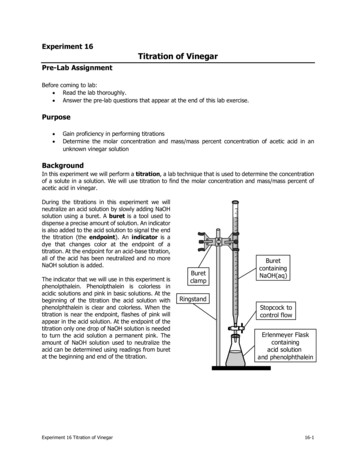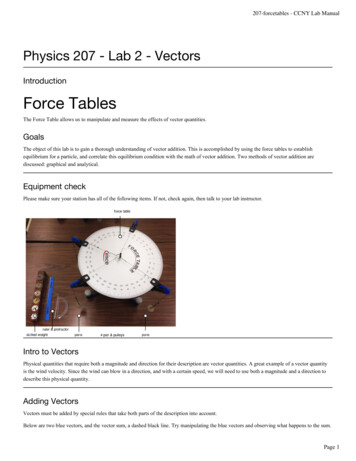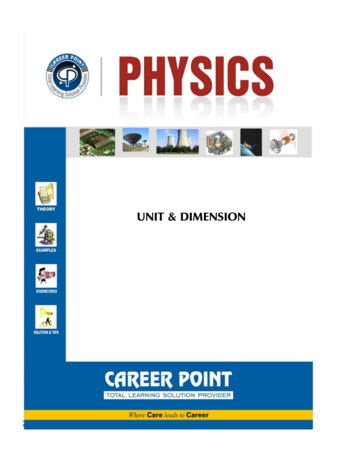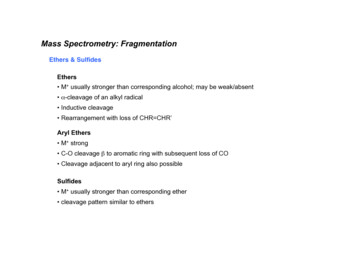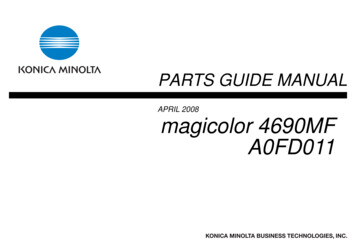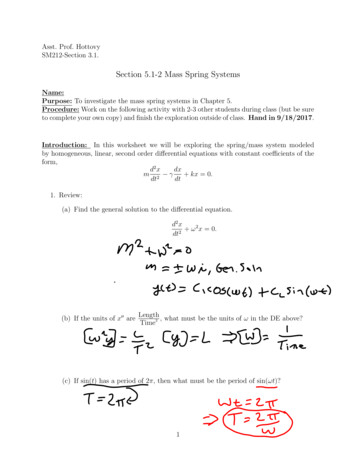
Transcription
Asst. Prof. HottovySM212-Section 3.1.Section 5.1-2 Mass Spring SystemsName:Purpose: To investigate the mass spring systems in Chapter 5.Procedure: Work on the following activity with 2-3 other students during class (but be sureto complete your own copy) and finish the exploration outside of class. Hand in 9/18/2017.Introduction: In this worksheet we will be exploring the spring/mass system modeledby homogeneous, linear, second order differential equations with constant coefficients of theform,d2 xdxm 2 γ kx 0.dtdt1. Review:(a) Find the general solution to the differential equation.d2 x ω 2 x 0.2dt(b) If the units of x00 areLength, what must be the units of ω in the DE above?Time2(c) If sin(t) has a period of 2π, then what must be the period of sin(ωt)?1
2. Spring mass systems with free motion: Consider a mass m attached to a spring inthe following pictureNote that the position (x) is positive when the spring is below the equilibriumposition. This means that velocity is positive when the mass is moving downward(falling in the direction of gravity).In the first picture, nothing is happening. In the second picture, the mass hangs stilland is unmoving. In the third picture, the mass is stretched and is currently moving(or about to be released and begin its motion).The equation of motion comes from Newton’s second law. Mass times acceleration isequal to the sum of the forces. The forces acting on the mass are gravity (mg) and therestoration of the spring (k(s x)). The restoration force comes from Hook’s law. Thes is the distance the mass hangs from the natural length of the spring. This is calledthe equilibrium position (middle picture above), and x is the distance of the massfrom equilibrium. We say thatat equilbrium.x With only these two forces acting on the mass, we can write the differential equationmx00 k(s x) mg kx mg ks kx. {z }zero(a) Discuss why mg ks 0 from above.2
This equation mg ks 0 is used to calculate the spring constant k. To do soyou must be given the weight of the mass (Example: 2lbs mg (remember lbsare a mass times gravity)) and the distance the spring stretches under the weightof the mass.(b) Calculate the spring constant k of the following spring mass systems.i. A mass weighing 4 pounds, attached to the end of a spring, stretches it 3inches. Calculate the spring constant k. What are the units?Solution: We use the equation mg ks 0, or mg ks. Here the weightof the mass is given aslbsmg For the ks part of the equation, we must be careful. In the text they state that“because we are using the engineering system of units, the measurements mustbe converted into feet.” So blame the engineers here, not the mathematicians.Sos 3 inches andft,1ks k.4Now solving for k gives,mg ks 4 k k 4.ii. A mass weight 24 pounds, attached to the end of a spring, stretches it 4inches. Calculate the spring constant. Watch the units!Solution:iii. A force of 400 Newtons stretches a spring 2 meters. Find the spring constantk.Solution: Here the weight of the mass is replaced by 400 Newtons. Somg 400. Thus solving for k gives,3
(c) A mass weighing 2 pounds stretches a spring 6 inches. At t 0 the mass isreleased from a point 8 inches below the equilibrium position with an upwardvelocity of 34 ft/s . Determine the equation of motion.i. Write the IVP.Solution: The spring mass equation for free motion ismx00 kx.We solve for k using the same strategy above,k .To write the mass of the spring we convert weight W to mass using,m W2 lbs g32ft/s2slug.The initial conditions are given by the sentence “At t 0 the mass is releasedfrom a point 8 inches below the equilibrium position with an upward velocityof 34 ft/s.” From this we get that (WATCH THE SIGN! Refer to the pictureon page 2)x(0) ftand the initial velocity is4ft/s3since the mass is traveling upward (refer to the picture on page 2). So theIVP is1 004x 4x, x(0) 2/3, x0 (0) 163ii. Solve this IVP.x0 (0) 4
3. Now try another on your own: A mass weighing 8 pounds, attached to the end of aspring, stretches it 8 ft. Initially, the mass is released from a point 6 inches belowthe equilibrium position with a downward velocity of 3/2 ft/s. Find the equation ofmotion.5
4. You should have a final answer ofx(t) 31cos(2t) sin(2t).24(1)It is difficult to answer the very physical question: “What is the maximum distancefrom equilibrium that the mass obtains?” To do so we write x(t) in a different form.Alternative form for x(t): For a general solutionx(t) c1 cos(ωt) c2 sin(ωt)where c1 , c2 are not zero, x(t) can be written asx(t) A sin(ωt φ)wherec1.c2A is called the amplitude and φ the phase angle. For the extra motivatedstudent: To see that this formula works, use the sine angle addition formulaqA c21 c2 ,tan φ sin(α β) sin(α) cos(β) cos(α) sin(β)and the picture below to rewrite the new form into the general solution in equation(1).(a) Find the amplitude and phase shift of the general solution in equation (1).6
5. Now consider the first example we did. The general solution wasx(t) 21cos(8t) sin(8t).36in the new form it is!x(t) sin 8t 6. Once we have this new form, the motion of the spring is much easier to visualize. NotetheNote that the sine wave flips when plotted below because the position is positivebelow the equilibrium position.Definitions: The period is the time it takes (in seconds) to execute a full cycle. For theexample above it is2ππ2π seconds.T ω84 The frequency is the number of cycles that the mass makes in 1 second. For theexample above it isf 1ω T2πcycles per second ω (in x00 ω 2 x) is called the circular frequency. For a mass spring system,ω2 kmThe circular frequency for the example above is,rkω cycles per secondm7
7. Solve the following problems.(a) A mass weighing 4 pounds is attached to a spring whose spring constant is 16lb/ft. What is the period of simple harmonic motion?(b) A 20-kilogram mass is attached to a spring. If the frequency of simple harmonicmotion is 2/π cycles/s, what is the spring constant k? What is the frequencyof simple harmonic motion if the original mass is replaced with an 80-kilogrammass?8
8. Free damped motion: Now we consider a mass on a spring in which there is friction.The friction force slows the motion. The force is considered to be proportional theinstantaneous velocity. So the differential equation for the mass spring is nowmd2 x kxdt2dx. β {zdt}friction forceWe rewrite this equation asd2 x dt2dx dtx 0.To make the analysis easier we rewrite this with new variablesx00 2λx0 ω 2 x 0where 2λ β/m, and ω 2 k/m.(a) Write the polynomial in m after we substitute x emt and simplifying. Solve thispolynomial for general λ and ω. (Please suppress the audible groan at having touse the quadratic equation.)(b) We saw from last section that the type of general solution that results dependson how many real roots come from the above polynomial. So we must considerthe cases of λ2 ω 2 . Why?9
9. Three cases: We consider the three cases for λ2 ω 2 and investigate the type of motion.(a) λ2 ω 2 0. For this case, the polynomial m2 2λm ω 2 0 hasrealroots. The roots are,m1 m2 .Thus the general solution is:(b) Which of the three graphs below graphs this case? Describe in words why.This case is called over damped. It is because the mass gets damped to equilibrium very quickly and does not have a chance to oscillate at its circular frequency(what it would do without friction).(c) λ2 ω 2 0. For this case, the polynomial m2 2λm ω 2 0 hasrealroots. The roots arem1 ,Thus the general solution is:10m2 .
(d) Which of the three graphs is this case? Describe in words why.This case is called under damped. It is called this because the friction doesnot damp enough to prevent oscillation. This could be bad if you do not wantoscillations. For example in some bridges.(e) λ2 ω 2 0. For this case, the polynomial m2 2λm ω 2 0 hasrealroots. This root ism1 Thus the general solution is:(f) Which of the three graphs is this case? Describe in words why.This case is called critically damped. It is called this because a slight changein spring constant or friction force would push the system to either over or underdamped. In mathematics, if a small change pushes you into 2 (or more) differentregimes, it is called critical.11
10. A mass weighing 8 pounds stretches a spring 2 feet. Assuming that a damping forcenumerically equal to 2 times the instantaneous velocity acts on the system, determinethe equation of motion if the mass is initially released from the equilibrium positionwith an upward velocity of 3 ft/s. Classify the motion as under, over, or criticallydamped.Solution: The set up for m and k are exactly as before. Find them,Next the frictional force comes from “Assuming that a damping force numerically equalto 2 times the instantaneous velocity acts on the system.” Thus the friction force is 2x0 .So the IVP isx00 2x0 x 0,x(0) x0 (0) ,.Relating the coefficients to the general case we just solved givesλ ω .Write the general solution and solve for the coefficients using the initial conditions.12
11. Solve the following:(a) A mass weighing 4 pounds is attached to a spring whose constant is 2 lb/ft. Themedium offers a damping force that is numerically equal to the instantaneousvelocity. The mass is initially released from a point 1 foot above the equilibriumposition with a downward velocity of 8 ft/s. Determine the time at which themass passes through the equilibrium position. Find the time at which the massattains its extreme displacement from the equilibrium position . What is theposition of the mass at this instant?Solution: Write the IVP for the problem.Solve the IVP and write the general solution.For “determine the time at which the mass passes through the equilibrium position”we find the time at whichx(t) see definition of equilibrium position on page 2Solve for tFor “find the time at which the mass attains its extreme displacement from theequilibrium position” We need to write the solution in the alternative form x(t) λtAe sin( ω λ2 t φ). This differs slightly from the one on page 6. Why?Write the solution in this form and what is the position of the mass at this instant?13
(b) A force of 2 pounds stretches a spring 1 foot. A mass weighing 3.2 pounds isattached to the spring, and the system is then immersed in a medium that offersa damping force that is numerically equal to 0.4 times the instantaneous velocity.i. Find the equation of motion if the mass is initially released from rest from apoint 1 foot above the equilibrium position. ii. Express the equation of motion in the form Ae λt sin( ω λ2 t φ)iii. Find the first time at which the mass passes through the equilibrium positionheading upward.14
12. The following problems may be free undamped or damped motion.(a) A 1-kilogram mass is attached to a spring whose constant is 16 N/m, and the entiresystem is then submerged in a liquid that imparts a damping force numericallyequal to 10 times the instantaneous velocity. Determine the equations of motionifi. the mass is initially released from rest from a point 1 meter below the equilibrium position, and thenii. the mass is initially released from a point 1 meter below the equilibriumposition with an upward velocity of 12 m/s.(b) A mass weighing 8 pounds is attached to a spring. When set in motion, thespring/mass system exhibits simple harmonic motion.i. Determine the equation of motion if the spring constant is 1 lb/ft and themass is initially released from a point 6 inches below the equilibrium positionwith a downward velocity of 3 ft/s. 2ii. Express the equation of motion in the alternative form A sin(ωt φ).iii. Express the equation of motion in the alternative form A cos(ωt φ).15
(c) A mass weighing 64 pounds stretches a spring 0.32 foot. The mass is initiallyreleased from a point 8 inches above the equilibrium position with a downwardveloc- ity of 5 ft/s.i. Find the equation of motion.ii. What are the amplitude and period of motion?iii. How many complete cycles will the mass have completed at the end of 3πseconds?iv. At what time does the mass pass through the equilibrium position headingdownward for the second time?v. At what times does the mass attain its extreme displacements on either sideof the equilibrium position?vi. What is the position of the mass at t 3 s?vii. What is the instantaneous velocity at t 3 s?viii. What is the acceleration at t 3 s?ix. What is the instantaneous velocity at the times when the mass passes throughthe equilibrium position?x. At what times is the mass 5 inches below the equilibrium position?xi. At what times is the mass 5 inches below the equilibrium position heading inthe upward direction?16
The period is the time it takes (in seconds) to execute a full cycle. For the example above it is T 2ˇ! 2ˇ 8 ˇ 4 seconds: The frequency is the number of cycles that the mass makes in 1 second. For the example above it is f 1 T ! 2ˇ cycles per second !(in x00 !2x) is called





